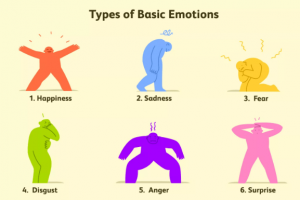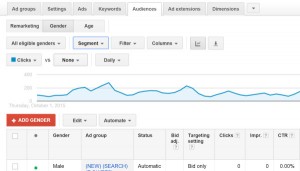If you are the proud owner of a new cloth mask, maybe you bought that mask from a seller on Etsy. And you’re in good company; I bought mine on Etsy, too! And maybe when you were scrolling through an endless supply of masks—tie-dye, sports-themed, silly mouths, and inspirational slogans—you stumbled upon some other cool merch. I’m a sucker for the vintage jewelry and needlepoint from Etsy sellers.
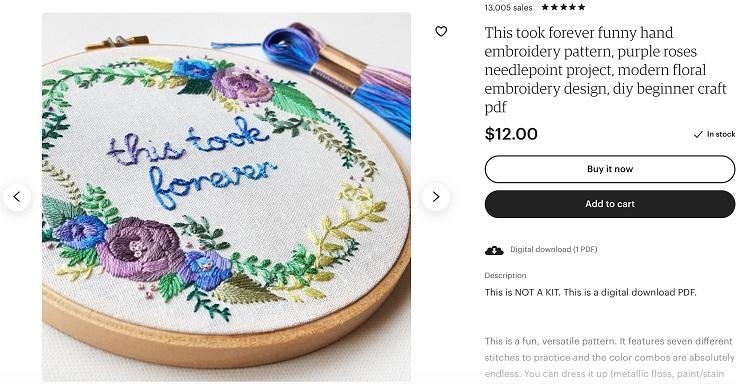
Etsy shops have exploded during the pandemic, not just with mask sellers, but with new boutiques started by people who got into “quarantine hobbies” or small businesses pivoting to ecommerce. If you’re looking to make some cash money from your side hustle, we’re going to break down exactly how to sell on Etsy, including:
- Why you should sell on Etsy
- How to set up your Etsy shop
- How to sell A LOT of your product on Etsy
Let’s get started.
Is selling on Etsy worth it?
The short answer is yes.
But let me explain. One of the best things about Etsy is that they help sell your merchandise. Yes, that means they advertise your items for you! So if you’re just getting started on your ecommerce adventure, Etsy is a great place to get your feet wet and crowd-test your products.
Etsy’s top sellers make $ 10,000 per year from their shops, and the platform boasts 31.7 million active buyers. This means that your products could be discovered by millions of people who would never hear of your business otherwise. The exposure and free advertising is a great place to kick off your custom-made craft business.
Particularly because the world of ecommerce can be fraught with scams, Etsy is a safe place to start. The platform truly teaches you best practices on how to sell your products, with plenty of hand-holding, community forums, seller handbooks, and a dedicated team to help sort out any issues you may run into.
How to set up your etsy shop
If you’ve bought items on Etsy before, you probably already have an account. If not, go ahead and set up a shiny new Etsy login. Once that’s all set, you’ll be able to start setting up your very own Etsy shop!
Set your shop preferences
The process is fairly simple. Etsy walks you through the step-by-step process below, starting with the basics: your shop language, country, currency, and a little bit about yourself as a seller.
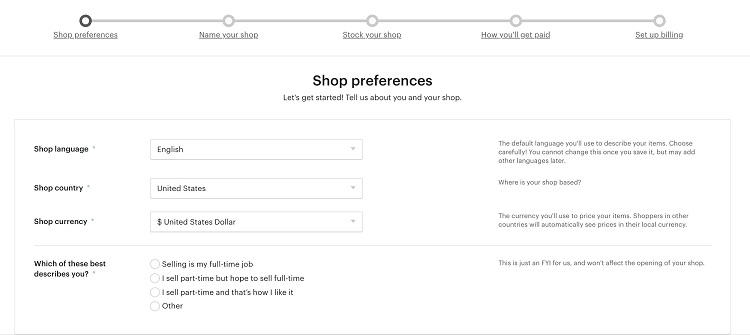
Name your Etsy shop
Truly, the toughest part is the next step: naming your shop. The pressure. is. on. I recommend naming your shop something broadly descriptive. For example, if you’re interested in selling fresh pizza dough and you want to name your name PizzaDoughOnly2000, think about how you might diversify or expand in the future. What if you want to sell bread one day? Or pizza toppings?
You can also go abstract, like “Rising Yeast 2020,” or add your name into the mix, e.g., Mary Lister Baking. Before you commit, google your Etsy shop name to make sure you’re not replicating an existing shop (on or off Etsy), or accidentally choosing a problematic name.
Finally, remember that capitalization and spelling matters! Proofread before you publish!
Stock your shop
Next, it’s time to stock up. This is the most laborious part of setting up your Etsy shop—but it’s easier than setting up an ecommerce website since Etsy lets you plug-and-play. They suggest adding ten or more items when you get started since shoppers love to have options.
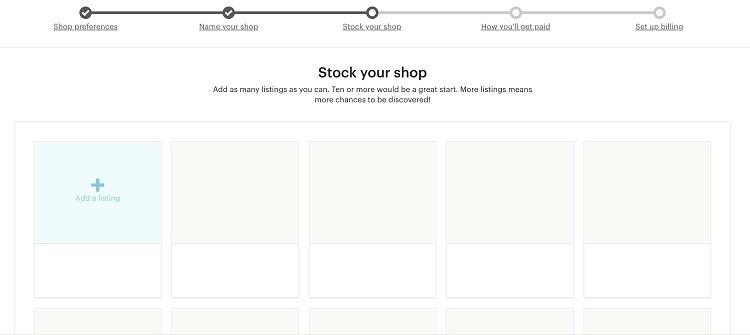
First, add your imagery. Etsy walks you through the best ways to take product photos—and, in exciting news, you can now add videos to bring your product to life! One video seems way easier than 15 pictures from different angles, and it’ll help give your shoppers a better understanding of the craftsmanship.
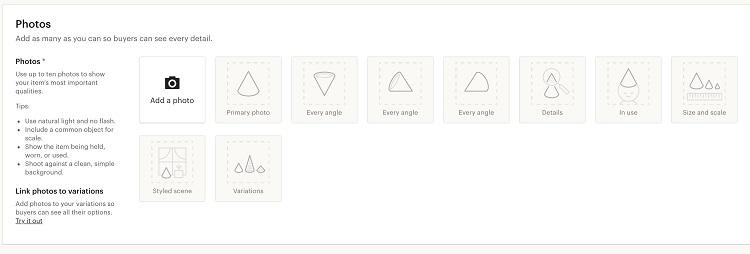
Next, you’ll be prompted to fill in details about your items. The options displayed below are mandatory fields and self-explanatory.
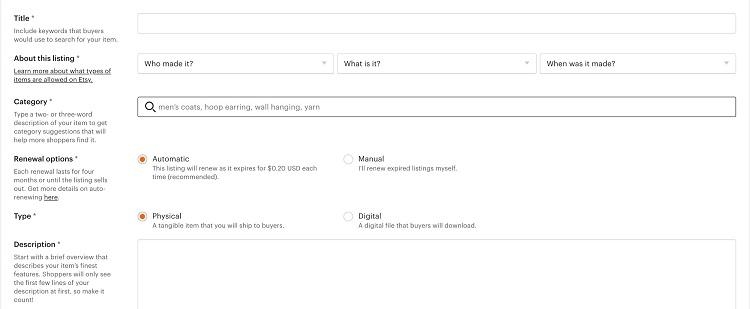
The next options involve creating sections in your shop. For instance, if you sell leather goods and want to break it down into wallets, purses, keychains, etc., as well as selecting tags to make it easier to search and find your goods, and the materials you used to create them.
Select pricing and shipping
If you’re already selling your wares elsewhere—maybe a swap meet or farmer’s market—pricing your products should be pretty easy. I would adjust pricing to include Etsy’s fees, which are $ 0.20 per listing and 5% of the item price when it is sold. You’ll have the option to assign SKUs to your products, display any variations (e.g., color, material, size), and allow a shopper to input personalization information.
After you set the price for your listing, you can set up shipping costs. While it may seem simple when you’re the shopper, stores meticulously choose what type of shipping costs they want to cover, build into the cost of the item or bill directly to you.
Etsy gives you the option of manually selecting the cost of shipping or having their algorithm calculate it for you. You’ll input the zip code you’ll be shipping from, how long it’ll take you to ship, if you want to ship internationally or just domestically (and which countries you can ship to), the types of shipping services, and allow you to add a handling fee. Finally, you’ll need to input the weight and measurements of your products to accurately estimate the total shipping costs.
How to get paid
You can enroll in Etsy Payments, which gives buyers a variety of ways to pay for your products, like Apple Pay, Paypal, major credit cards, Google Pay, and Etsy credit and gift cards. It means all the money you collect from sales can be directly deposited in your account, in your own currency, on a regular basis. Etsy requires all eligible sellers to enroll in Etsy Payments to provide a more consistent shopping experience for their users, but … it’s unclear how you wouldn’t qualify for Etsy Payments. Otherwise, you can select your own preferences for which payments you’ll accept from buyers.
Set up billing
Final step! You need to attach a line of credit (credit card) to your brand new shop in order to pay Etsy’s seller fees. Make sure you understand all of Etsy’s fees before you dive in. It can get complicated, and while it probably isn’t expensive off the bat, the fees can add up. Check out more detail on those fees here.
How to sell A LOT on Etsy
There you have it—getting started selling on Etsy is straightforward. But it can be difficult to stand out from the crowd on Etsy. That’s why we rounded up some quick tips to make you’re not just selling on Etsy but selling a lot on this platform.
Do some competitive research
Before you start selling, check out your favorite Etsy stores to see what stands out to you! Why did you pick those sellers—was it the description of their offerings? The materials they use? The efficiency in shipping and handling? Identify the best traits in each shop so you can replicate them in yours for an optimal buying experience for your own ecommerce brand on Etsy.

Follow the guidelines
Follow the guidelines for what to sell—more specifically, what you’re allowed and not allowed to sell. Etsy is different from ecommerce platforms like, say, Amazon or eBay. Etsy requires their sellers to offer unique items. That means you need to be selling vintage, handmade, or craft supplies to open an Etsy shop. Etsy has an article about items that are prohibited from sale on their site, which you can view here.
Tell your brand story in your Etsy profile
Take the time to tell your brand story in your shop description. Like cooking blogs, with cool backstories about where they found the recipe and how they adjusted to make it their own, it’ll draw shoppers in. Kingsley Leather explains his leather working journey in his shop description; how he began working with leather as a hobby and eventually made it his full-time job.
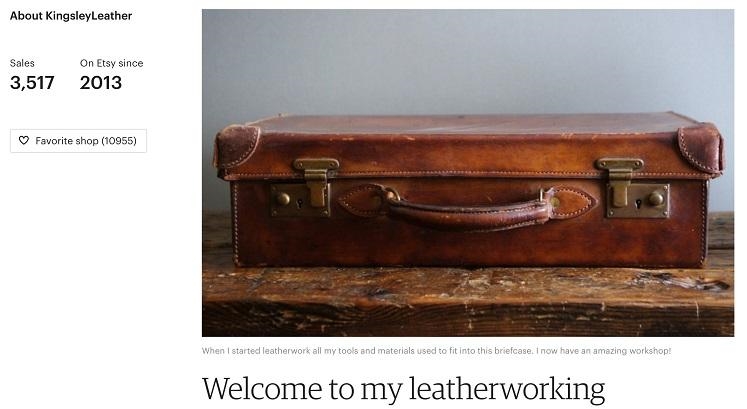
He also dives into why he values quality leather products, namely, that he was sick of cheaply made goods and hated wearing through wallets quickly. This particular tidbit is great marketing; sure, his products may be expensive, but they’re worth it.
Connect your social media accounts
Connect your social media accounts and website for your business. This gives shoppers more options if they want to see your designs IRL (online), you can show off new projects you’re working on, and promote your buyers through your social channels. Think of it as a great way to get more followers on social, more buyers on Etsy, and, even better, it can help you sell more goods that may not meet Etsy’s guidelines.
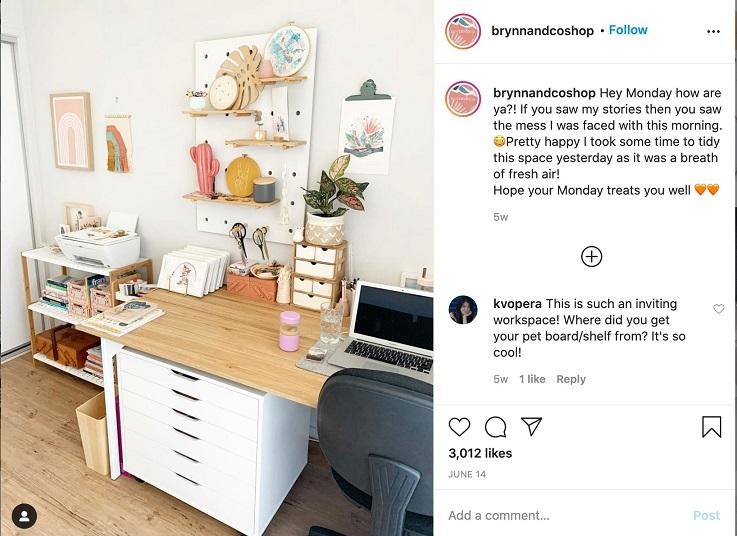
BrynnandCo connected her Instagram, Facebook, and Pinterest, so you can take a peek into her work studio and see more of how she displays her finished products–needlepoints!
Keep your availability and estimates up to date
If you’re on vacation or experiencing difficulties with productivity, make an announcement so your shoppers know what to expect. This will prevent disappointments if they can’t get their item on time or can give buyers a heads up if you’re about to drop a new line of cool new shirts. Even better, provide them with a discount code for their patience, as The Fro Experts did.

The first step to selling on Etsy: Go and get started!
And there you have it—everything you need to know about how to sell on Etsy, a platform that offers everything. If you want anything handmade and personalized, unique and crafted, it’s on Etsy. And I’m all for it. I’ve even taken a dive into taxidermy Etsy (yes, it’s really real), vintage board game Etsy, and miniature doll Etsy for photoshoots, which *did not* disappoint. If you have a unique product created with your own two hands, Etsy is the place to sell. Good luck out there!
Digital & Social Articles on Business 2 Community
(84)
Report Post

